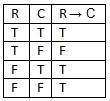The material conditional is probably the trickiest operator to figure out, even though it seems pretty straightforward. It’s usually symbolized as P → Q, which means “If P, then Q.” Like I said, seems straightforward. But let’s dig a little deeper.
 In P → Q, P is referred to as the antecedent, and Q as the consequent. An example of this is “If it’s raining, then it’s cloudy”, or R → C. If R is true, then C is true. But if C is true and R is false, R → C is still true. Think of it this way: it’s true that if it’s raining, it’s cloudy, but it can be cloudy without it raining, and it can be neither raining nor cloudy, but neither of those make it not true that if it is raining, then it’s cloudy. The only time the statement “If it’s raining, then it’s cloudy” is false is if it’s raining and it’s not cloudy.
In P → Q, P is referred to as the antecedent, and Q as the consequent. An example of this is “If it’s raining, then it’s cloudy”, or R → C. If R is true, then C is true. But if C is true and R is false, R → C is still true. Think of it this way: it’s true that if it’s raining, it’s cloudy, but it can be cloudy without it raining, and it can be neither raining nor cloudy, but neither of those make it not true that if it is raining, then it’s cloudy. The only time the statement “If it’s raining, then it’s cloudy” is false is if it’s raining and it’s not cloudy.
And that makes sense, because clouds cause rain. But let’s look at a different statement. “If the cat is on the mat, then it’s raining.” We can symbolize that as M → R. It makes no sense, but has the exact same structure. If it has the same structure, then it has the same truth table. Which means that if we see the cat on the mat, and it’s raining outside, then M → R could be true. In order to show that it isn’t, we’d need to show that M can be true while R is false. If we see the cat on the mat and it’s a sunny day, then M → R isn’t true. It’s easy to think that the if/then of the conditional signifies a cause, or a logical implication, but it doesn’t have to.
The material conditional interacts with other operators just like disjunction and conjunctions do, by chaining them together. We can have (M  K) ? (C
K) ? (C  S), or any combination of the above. We can even negate the whole statement, like this: ~((M
S), or any combination of the above. We can even negate the whole statement, like this: ~((M  K) ? (C
K) ? (C  S)). In plain English, that could read “It is not the case that if the cat is on the mat or the cat is in the kitchen, then it is cold and it is snowing.” Our everyday language and argument structure can often be broken down into these more complex statements. The value in doing so is that it can show us how each proposition relates to the others, and help us show that the conclusion is valid.
S)). In plain English, that could read “It is not the case that if the cat is on the mat or the cat is in the kitchen, then it is cold and it is snowing.” Our everyday language and argument structure can often be broken down into these more complex statements. The value in doing so is that it can show us how each proposition relates to the others, and help us show that the conclusion is valid.
Bonus!
 There’s one last operator, and it’s a quick one. The Biconditional is symbolized with ≡, and means “if and only if”. Think of it as a material conditional that goes both ways, because that’s exactly what it is. It connects the propositions such that the statement can only be true if they’re both true or both false.
There’s one last operator, and it’s a quick one. The Biconditional is symbolized with ≡, and means “if and only if”. Think of it as a material conditional that goes both ways, because that’s exactly what it is. It connects the propositions such that the statement can only be true if they’re both true or both false.
And that’s it for operators! What do these all mean when applied to real life? Well, that’s a topic for next week. Thanks for reading!

7 Comments